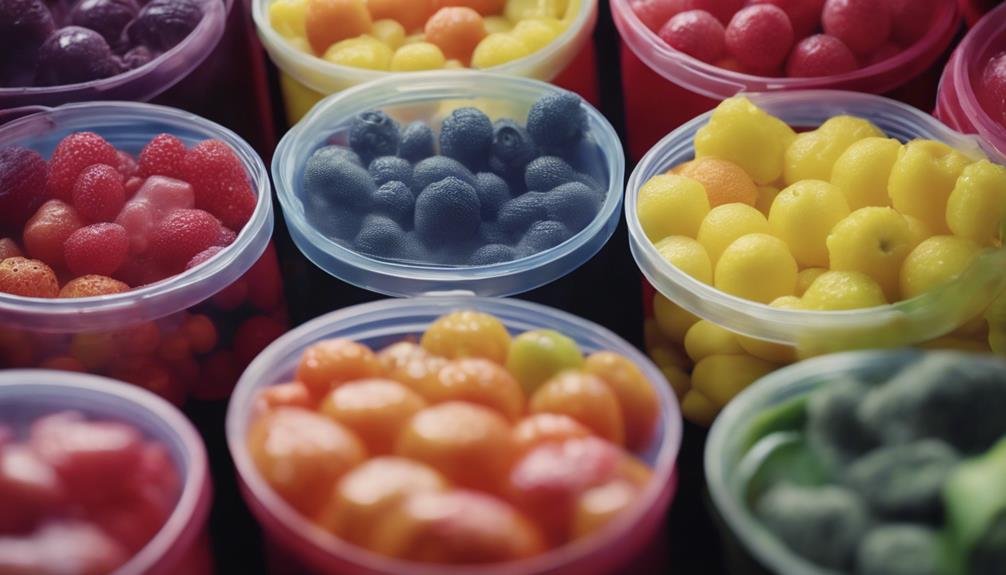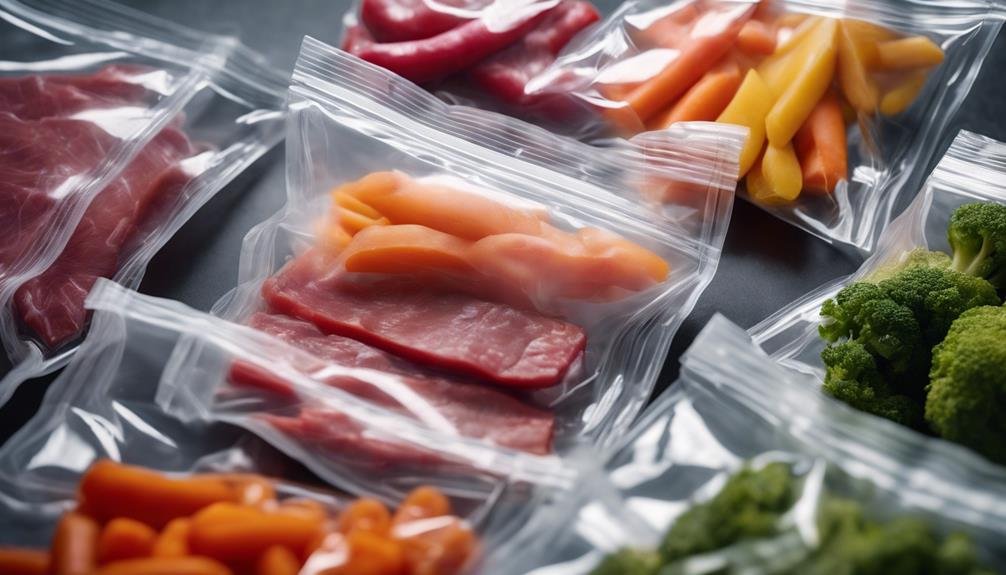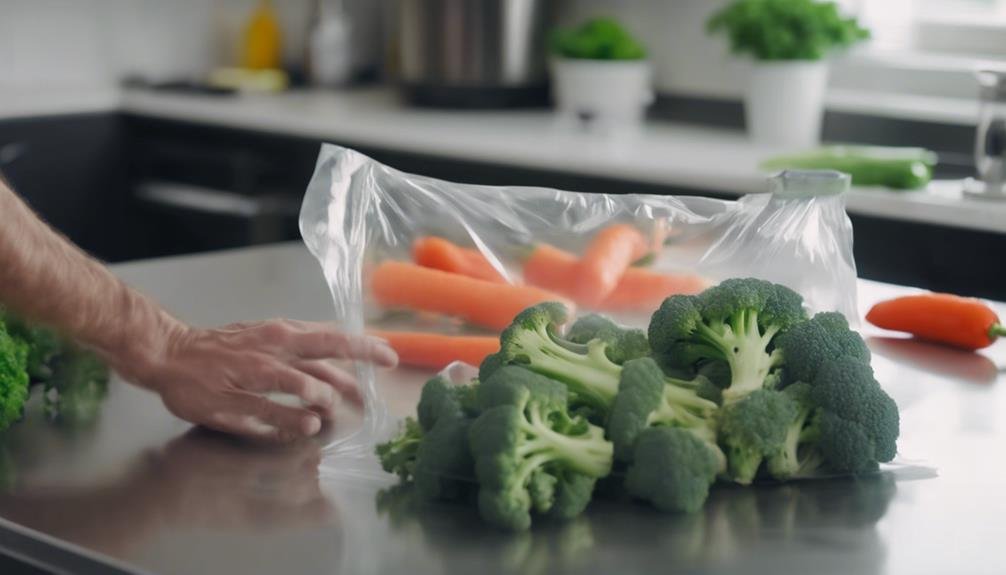Vacuum sealing is an effective way to avoid harmful chemicals in food storage. By removing air and creating an oxygen-depleted environment, it extends shelf life and enhances food safety. Unlike traditional storage methods, vacuum sealing minimizes exposure to chemicals like BPA and phthalates. It's ideal for various foods, including meats, cheese, dry goods, and vegetables. To get started, you'll need a BPA-free vacuum sealer, food-grade bags, and canisters. Remember to check for air leaks, use high-quality bags, and store sealed items properly. With the right equipment and techniques, you'll be on your way to safer, longer-lasting food storage. Discover how vacuum sealing can revolutionize your kitchen and health.
Benefits of Vacuum Sealing
Three key benefits of vacuum sealing make it an invaluable food storage method you'll want to explore. First, it greatly extends the shelf life of your food. By removing atmospheric oxygen, vacuum sealing creates an anaerobic environment that slows down food deterioration. This technique is particularly effective for refrigerated, dried, and frozen foods, allowing you to store them for longer periods without compromising quality.
Second, vacuum sealing enhances food safety. By maintaining an oxygen-deficient environment, it inhibits the growth of harmful bacteria and mold that can cause foodborne illnesses. This is especially important for meat products, which are highly susceptible to spoilage. In fact, 97% of beef in the USA is vacuum packaged for safer transportation and storage.
Lastly, vacuum sealing preserves food freshness. It creates a hermetic seal similar to canning, locking in flavors and nutrients while preventing freezer burn and dehydration. This means you can enjoy fresher-tasting food even after extended storage periods.
How Vacuum Sealing Works
Now that you've learned about the benefits of vacuum sealing, let's explore how this process actually works to preserve your food.
Vacuum sealing is a remarkably effective method that removes air from food packaging, creating an oxygen-depleted environment. This reduction in oxygen is key to slowing food deterioration and inhibiting bacterial growth.
When you vacuum seal your food, you're basically mimicking the effects of canning. The process creates an anaerobic environment that greatly extends the storage life of various food products, especially meats. By removing oxygen from the package, you're depriving bacteria of the element they need to thrive and multiply.
This oxygen-deficient atmosphere is particularly effective for preserving fresh meat. In fact, a large percentage of beef in the USA is vacuum sealed for distribution. The technique is also beneficial for refrigerated, dried, and frozen foods, maintaining their freshness and quality for extended periods.
Chemicals in Traditional Food Storage

You're likely unaware of the hidden dangers lurking in your traditional food storage methods. The plastic containers and bags you use to store your food may contain harmful chemicals like BPA and phthalates. These chemicals can leach into your food, especially when exposed to heat or acidic foods, potentially posing health risks.
Here's a comparison of traditional food storage and vacuum sealing:
| Aspect | Traditional Storage | Vacuum Sealing |
|---|---|---|
| Chemical Exposure | High risk | Low risk |
| Food Safety | Moderate | High |
| Shelf Life | Short to medium | Extended |
| Versatility | Limited | Wide range |
| Cost-effectiveness | Varies | Generally high |
Vacuum Sealing Vs. Other Methods
While traditional storage methods pose risks, let's examine how vacuum sealing compares to other food preservation techniques regarding safety and effectiveness. When you vacuum seal food, you're creating an environment with greatly reduced oxygen, which offers several advantages over different packaging methods.
Vacuum sealed food is less susceptible to bacterial growth due to the oxygen-depleted environment. This means your food stays fresher for longer without the risks associated with traditional storage methods.
Unlike plastic containers or bags that may contain harmful chemicals like BPA or phthalates, vacuum sealing minimizes your exposure to these potentially dangerous substances.
Reduced oxygen packaging also helps prevent chemical leaching, a common concern with other storage methods. By removing air from the packaging, you're creating a barrier that inhibits the transfer of harmful chemicals into your food. This makes vacuum sealing a safer option for long-term storage.
While there are some risks with vacuum sealing, such as the potential for anaerobic bacteria growth if not done properly, it generally offers a more reliable and safer method for preserving food compared to other techniques.
Best Foods for Vacuum Sealing

From preserving fresh meats to extending the shelf life of dry goods, vacuum sealing offers numerous benefits for a wide variety of foods.
When it comes to choosing the best foods for vacuum packaging, you'll want to focus on items that are prone to spoilage or oxidation.
Fresh meats, fish, and poultry are ideal candidates for vacuum sealing, as this method can greatly extend their shelf life in the refrigerator or freezer. Cheese is another excellent option, as vacuum packaging can help prevent mold growth.
For dry goods like grains, nuts, and coffee beans, vacuum sealing is perfect for maintaining freshness and preventing oxidation, which can affect flavor and quality.
Don't forget about vegetables! While not all produce is suitable for vacuum sealing, vegetables like carrots, bell peppers, and green beans can be preserved after blanching. This process helps maintain their nutrients and texture.
Soups, stews, and sauces are also great for vacuum packaging, as it prevents freezer burn and preserves their flavors. Even baked goods like bread, cookies, and muffins can benefit from vacuum sealing, keeping them fresh longer and preventing staleness.
Equipment and Supplies Needed
To safely vacuum seal your food, you'll need several key pieces of equipment and supplies that are free from harmful chemicals. Start with a reliable vacuum sealer made from safe materials like stainless steel or BPA-free plastics. Pair this with BPA-free vacuum sealer bags or food-grade silicone bags to make sure your food remains uncontaminated.
When selecting your equipment and supplies, prioritize items labeled as free from harmful chemicals such as BPA, phthalates, and other plasticizers. Consider the following options:
| Equipment | Safe Option | Features |
|---|---|---|
| Vacuum Sealer | Stainless Steel Model | Durable, easy to clean |
| Storage Bags | Food-grade Silicone | Reusable, sustainable |
| Accessories | BPA-free Canisters | Versatile storage |
Don't forget about additional accessories like vacuum canisters or jar sealers. These should also be certified as safe for food storage and free from estrogenic activity (EA). By choosing environmentally-friendly options like reusable silicone bags, you'll not only safeguard your food from harmful chemicals but also reduce waste. Remember, investing in high-quality, safe equipment and supplies is essential for maintaining the integrity of your vacuum-sealed food and protecting your health in the long run.
Tips for Effective Vacuum Sealing

Now that you've got the right equipment, let's focus on how you'll use it effectively to keep your food safe and chemical-free.
When vacuum sealing for food storage, always check for air leaks or loose seals in the package to guarantee proper sealing. This step is essential for maintaining freshness and preventing contamination.
Choose high-quality vacuum sealing bags made from safe materials like polyethylene and nylon. These materials are less likely to leach harmful chemicals into your food. Remember to store your vacuum-sealed items in a cool, dark place away from direct sunlight to preserve their quality and avoid potential chemical reactions.
It's important to resist the temptation to reuse vacuum sealing bags, as they may have absorbed harmful substances from previous use. Instead, opt for fresh bags each time to minimize the risk of chemical exposure.
Lastly, always follow the manufacturer guidelines for your vacuum sealer. These instructions are designed to ensure top-notch performance and safety of the machine.
Conclusion
You've now got the lowdown on vacuum sealing for safer food storage. It's time to put your money where your mouth is and give this method a try.
By investing in vacuum sealing equipment, you'll reduce exposure to harmful chemicals and extend your food's shelf life. Remember the tips shared, choose the right foods, and you'll be well on your way to healthier, longer-lasting food storage.
Happy sealing!
